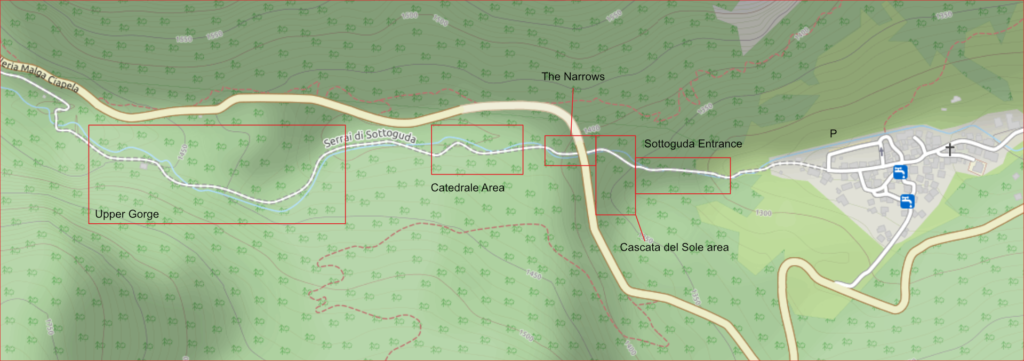Serrai di Sottoguda, Val Pettorina
The Serrai di Sottuguda is a deep slash through the base of Val Pettorina formed during the ice ages as glacial meltwater gouged down through the rock. It is a UNESCO site, as is Marmolada which towers above the gorge to the west. So narrow in places that the walls almost meet, this natural phenomenon ticks every box you can think of as an ice climber. With a total of 29 routes in the guide book (and a bunch which aren’t!), it’s a really extensive venue to visit.
The valley which faces east-west is very deep, hidden from the sun through most of the winter and acts as a cold sink for air dropping from Marmolada’s glacial north face. With temperatures in November usually in the minus figures and water pouring into the 150m deep gorge from both sides of the valley, conditions couldn’t be more perfect for an ice climber.
Access
Please note – there is officially no current access allowed to the gorge. If you enter, you do so at your own risk, and also if caught may be taken to task by the Carabinieri.
This is what makes the Serrai di Sottoguda so appealing – essentially roadside ice. The car park at the end of Sottoguda village is large and only occasionally full. From here take the small road which leads uphill into the gorge. Within 3 minutes from the car you will reach the first icefalls, and the far end of the gorge is a further 20 minute walk uphill. Alternatively you can park in Malga Ciapela and walk down into the gorge if you plan to climb higher up the valley.
Routes
Over its 2km length, amongst its 29+ lines, the gorge has a great number of classic routes. I’ve decribed the canyon from it’s lowest end, nearest Sottoguda and in sections to make it a little clearer.
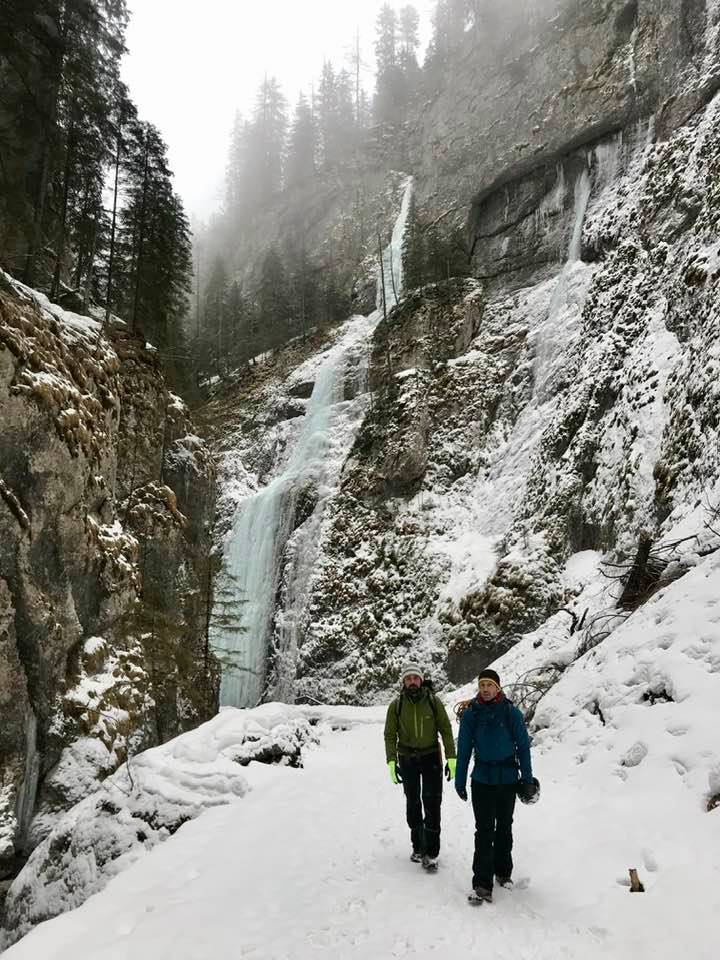
Sottoguda Entrance
Starting just after the gorge office building the gorge narrows. This is home to various shorter routes, both mixed and ice and finishes by the large cave with a Madonna in it.
Baby WI3 15m
The first ice fall on the right as you enter the gorge from the village. Although short, it is worthwhile as a warm up or for beginners. The belay is equipped with bolts.
El Dent del Guidizio WI5+/M5 15m.
Just to the left of Baby, there is a cave. Climb the initial wall to this, then climb to the hanging ice with sections of M5. Descent is by abseil from the trees above.
Baby Killer WI5+ 25m
The climbs the wall opposite and slightly further up from Baby. It is short but hard with difficult protection as the ice forms very thinly over a slab. There is risk of a ground fall with the ground being the river below!
Luna Nera WI6 25m
Another short, extreme route with ground fall potential. The route starts just as the river disappears beneath the roadway and climbs a corner by a section of brutal looking mixed climbing. Higher it reaches a smear of ice which is climbed to the end of the route.
2 mixed/dry routes which are fully bolted exist on the right side of the gorge.
Cascata del Sole Bowl
Straight after the Madonna the gorge opens out into a large bowl, dominated by the fantastic Cascata del Sole on the right.
Immediately on the right there is a line of bolts in a cave – currently I do not know what this line is, presumably either a summer line or an tough drytooling line, although the bolts look old.
Cascata del Sole WI3+, 3 pitches, 80m ***
One of the few routes to receive full sunlight, this route comes with the usual caveat. However, choose an early morning ascent or a late afternoon time and you may just strike the right conditions. A massive volume of ice which funnels down to a narrow gap at its top. The access pitch climbs to a small cave with a bolted belay. You can either stop here or continue up the initial steep section to a bolted belay on the right. This is advisable for afternoon ascents as the second belay is far over to the right and out of the way of dripping water and falling ice. It also allows you to assess the condition of the upper falls which are slender at the best of times.
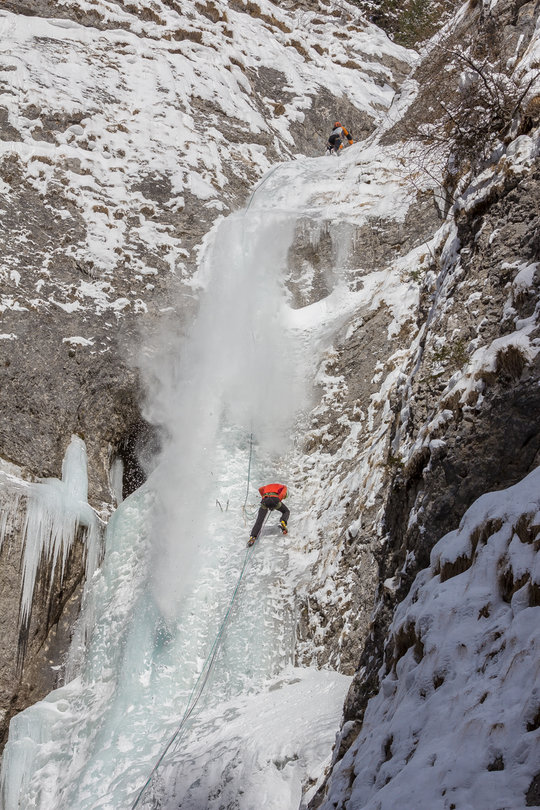
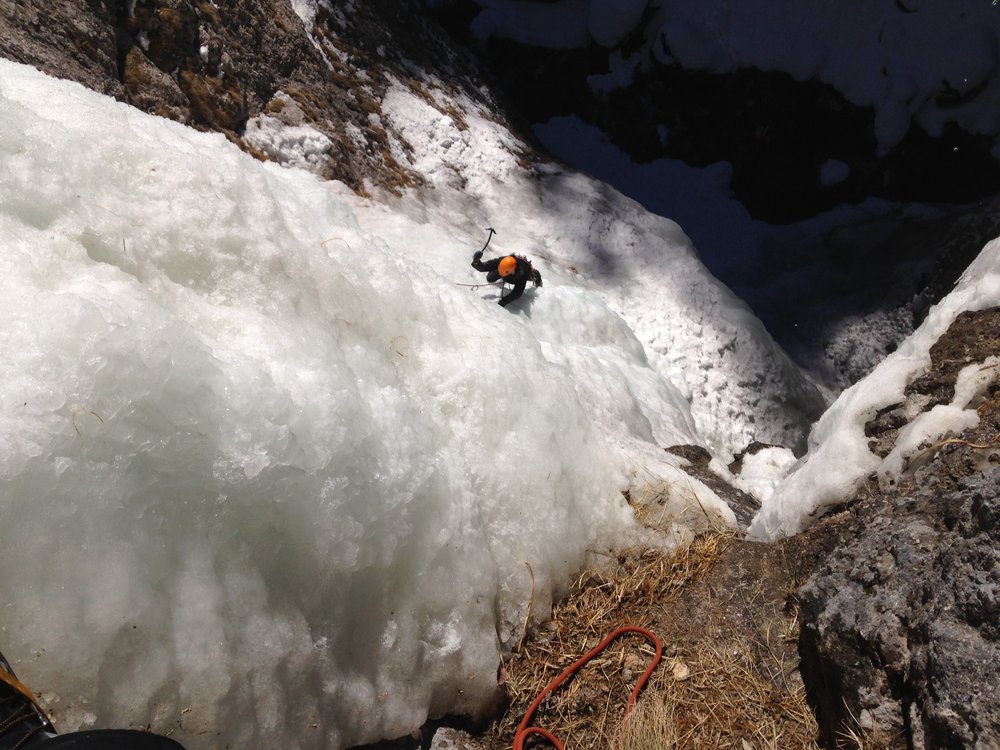
Le Ciandeline WI3+, 30m
The first pitch is often climbed in it’s own right. There are two lines above, one slightly harder than the other. However in recent years these have been slow to form fully. Climb a short free standing pillar to an easier ramp, usually covered with snow. Climb up to a tree (currently there is a tree which has fallen across the path making gaining the tree awkward. Either descend from here or traverse rightwards to the step upper pitches. The line on the right is climbed at WI4, the one on the left 4+. Abseil from trees if possible as above there is steep, snowy ground which often is difficult to wade through.
The Narrows
Immediately after the bowl the gorge pinches down into a very tall, narrow section with the road bridge going directly overhead. There is a high concentration of hard routes in this area, mainly on the left side of the gorge but also there are some dry routes on the right.
Cascata del Serrai WI6+, 2 pitches 90m
This rare line climbs a huge hanging curtain of ice which descends from the buttress below the road over a large overhang. Climb to the cave formed by the curtain, belay and then very very carefully climb the curtain to reach more sucure graound above. A big tick.
Clessidra WI3+, 25m*
Nice climbing although a little broken with an easier middle section. The route which starts beneath the road bridge on the left hand side of the gorge. Jumping over the barriers allows access to a point at which the river goes beneath the gorge wall and affords an easy step across to the ice. After an initial steep to vertical section above the river, the ice becomes shallower and more stepped leading you to a bolted belay.
Abseil descent.
Simpatiche Canaglie WI5+/M6, 3 Pitches, 85m
Mister Wawowi WI5/M8+, 3 Pitches 60m
Star TrekWI6+/M6, 2pitches 80m
This rarely formed route represents an advance in climbing at Sottoguda, ushering in the use of bolts to protect climbing. It has mixed climbing with sections of M6. The route climbs an old rock route – you will find some old pegs in place which should be treated with caution owing to the damp nature of the gorge in the summer!
Abseil the route.
La Roccia Nella Spada, WI5/M7+, 2 pitches 45m
Beneath the road bridge you will find the famous Spada nella Roccia. This twin route runs paralell and to the left of the huge column of ice up an obvious corner with sections of hard drytooling and climbing up to M7+. At the end of the route, climb right to the belay of Spada on a ledge.
Abseil of bolts.
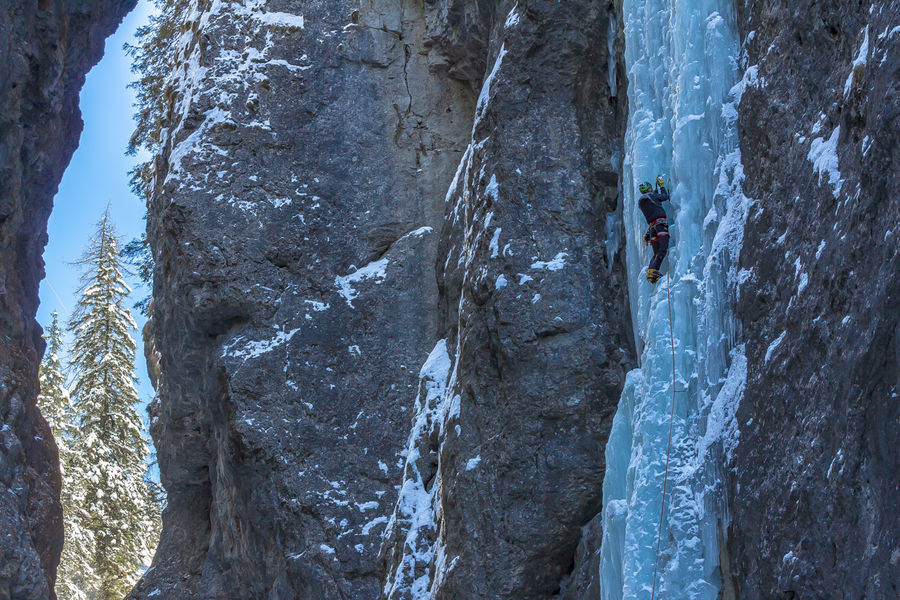
Spada nella Roccia, WI5 40m ****
This is a route of national importance and the first ascent during the 80’s represented a major leap forwards as far as Piolet Traction was concerned. As such it is regarded as one of the finest routes in Italy, if not the Alps. Dropping directly from a ledge beneath a road bridge, the route is unremittingly steep, although its nature is often highly featured. Generally climbed on its right hand side, you will need a full complement of screws to tackle this route.
There are three dry routes on the right side of the gorge, currently I don’t have details for them.
Spirale della Contingenzia WI4+, 4 pitches 110m
Strictly speaking this comes after the narrows, where the gorge opens up again into a tall amphitheatre. This route climbs the enormous diedre to the right of the gorge. It only forms in exceptionally good conditions as it is extremely long and requires extended cold and a plentiful supply of water from the slopes above. When it does form though it is a very impressive and imposing feature.
La Catedrale area
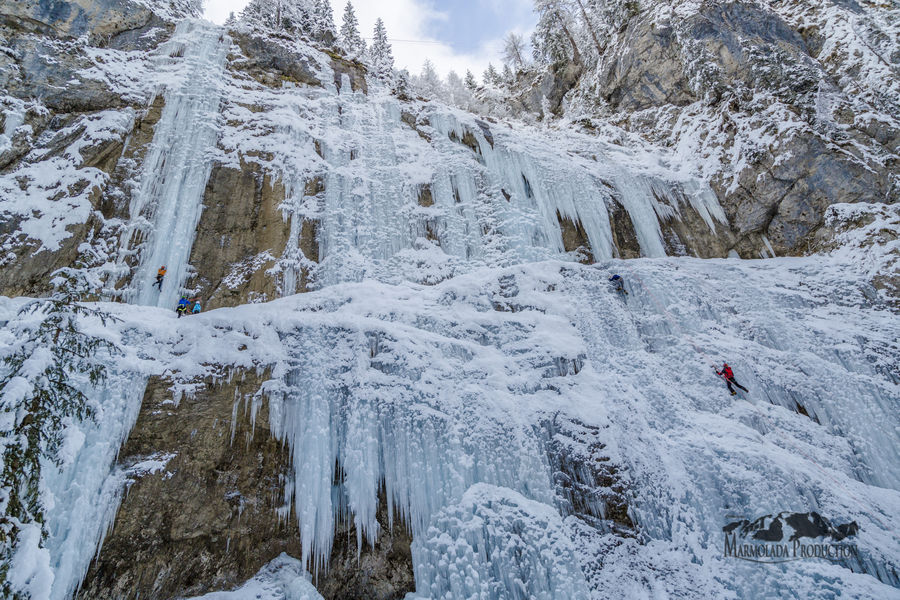
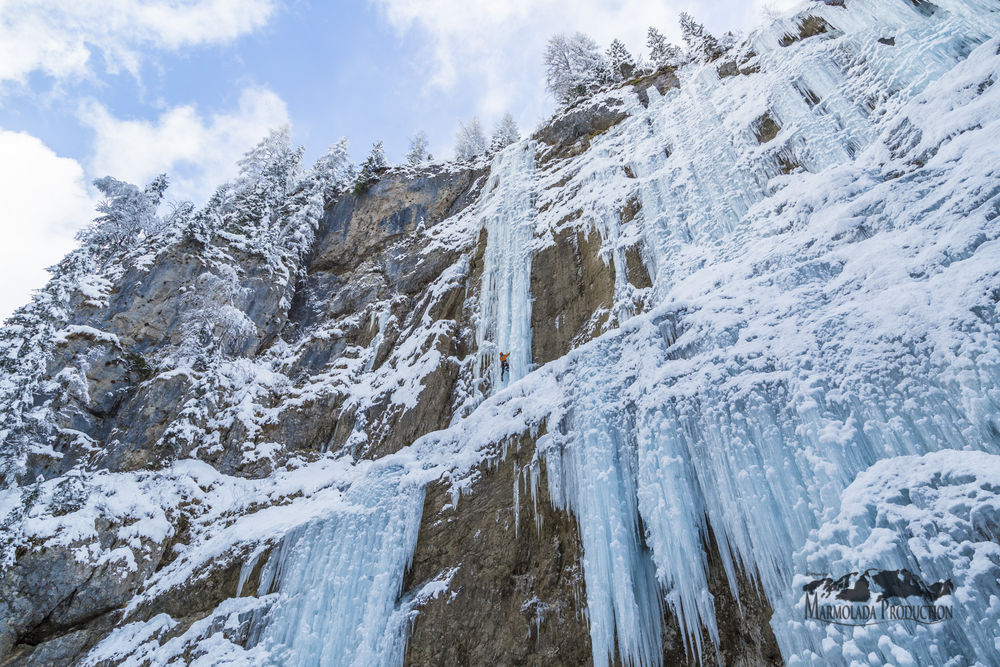
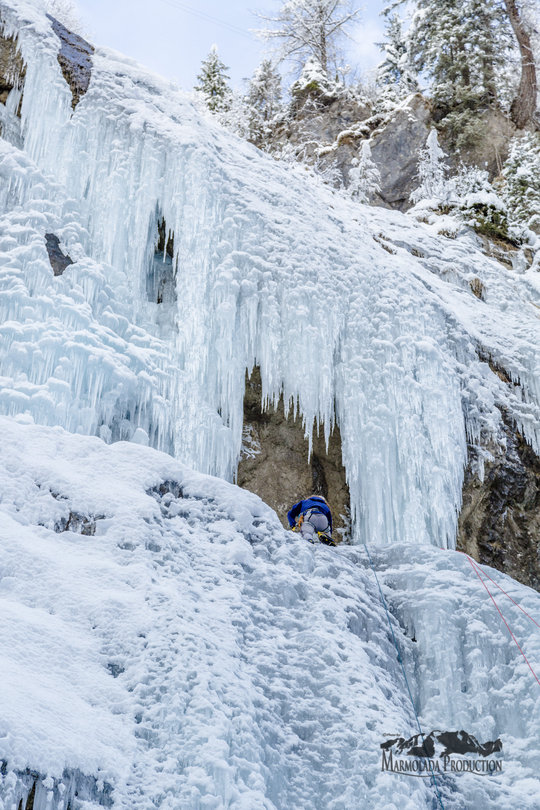
The Catedrale is an utterly stunning cascade, so wide that it supports at least 4 independent lines, all of which have first pitches that are frequently climbed in their own right and on many lines, usually dependent on where the boulders are located in the stream bed! All of them are classic and see very regular ascents, with perhaps the exception of “sinistra”, the WI 6 mammoth at the far left side of the falls. Walking up the gorge, the falls are utterly unmistakable as they are simply huge.
Cascata del Gelato WI3, 15m
Before reaching La Catedrale there is a short quite an enclosed line, on the right with the upper section following an almost chimney like section. It’s great as a warm up or for beginners and is slightly awkward which makes it fun! Start in asmall cave and climb up and left to some chains.
Destra Destra WI5, 2 pitches, 100m ***
Climb the extreme right of the cascade below an obvious pillar. Belay beneath a curtain of ice in a cave on bolts. Climb the steep, freestanding pillar to a vertical wall above which gradually eases with height
Destra WI4+, 2 pitches, 100m ***
Several lines possible, with a max of 2 freestanding pillars forming to the right of the falls. Climb WI 4 lines of your choosing to the halfway ledge. In the rock section, you will find at least 2 fixed belay/abseil stations. Then choose between the Right, Central or Left hand lines. All are steep mushroomed ice. The pillars take time to form but are often thick and solid. Be careful with the left hand variant exit as it can be thin in early season.
Centrale WI5, 2 pitches, 100m ***
The first pitch attacks the steep central groove of the first tier. The second follows a wide steep wall with relatively few spots to take a break.
Sinistra WI5+/6, 2 pitches, 100m ***
The left hand variant is usually the last to form as it is an immensely slender column of ice, with intricate, steep climbing. The main upper pitch is a colossal 60m pitch and it’s truly breath taking to watch climbers picking their way up it.
Cascata delle Attraversate WI4, 2-3 pitches, 100m ***
On the opposite side of the valley, there is an obvious and tall cascade which starts with a wide shallow slab of ice, followed by two pillars, one on the left, on on the right
The first pitch is also climbed as an ideal beginner’s/warm up route at about WI2+. At the top of this pitch, belay to the left and then climb a steep, mushroomed column to a ledge. Either belay here or continue by traversing the ledge to a final pillar. The falls can be climbed directly to the final pillar which looks to be 4+ or 5.
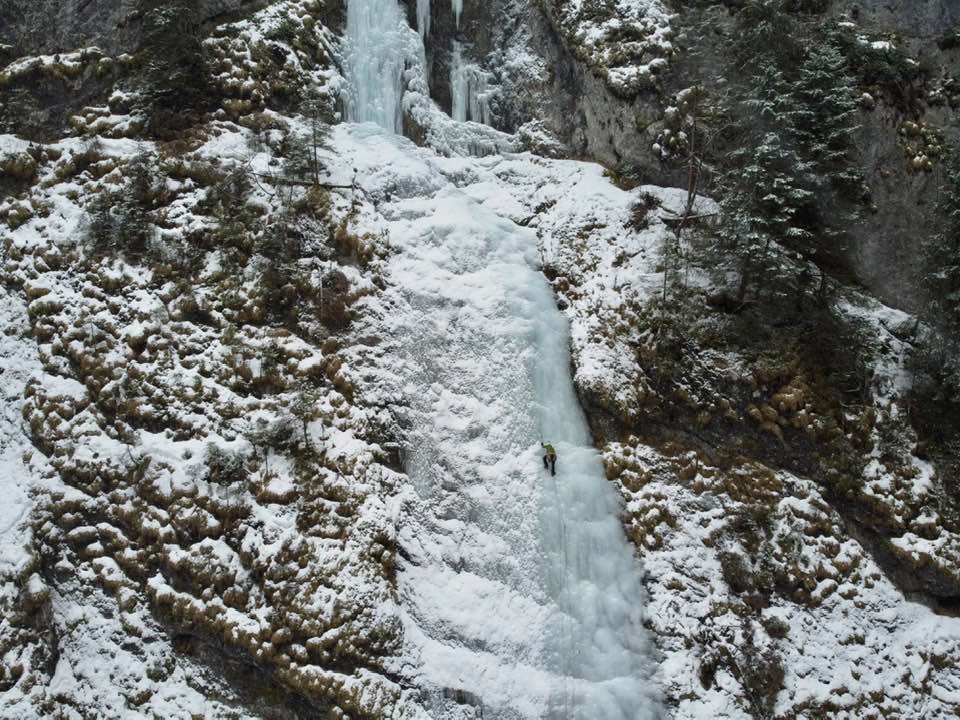
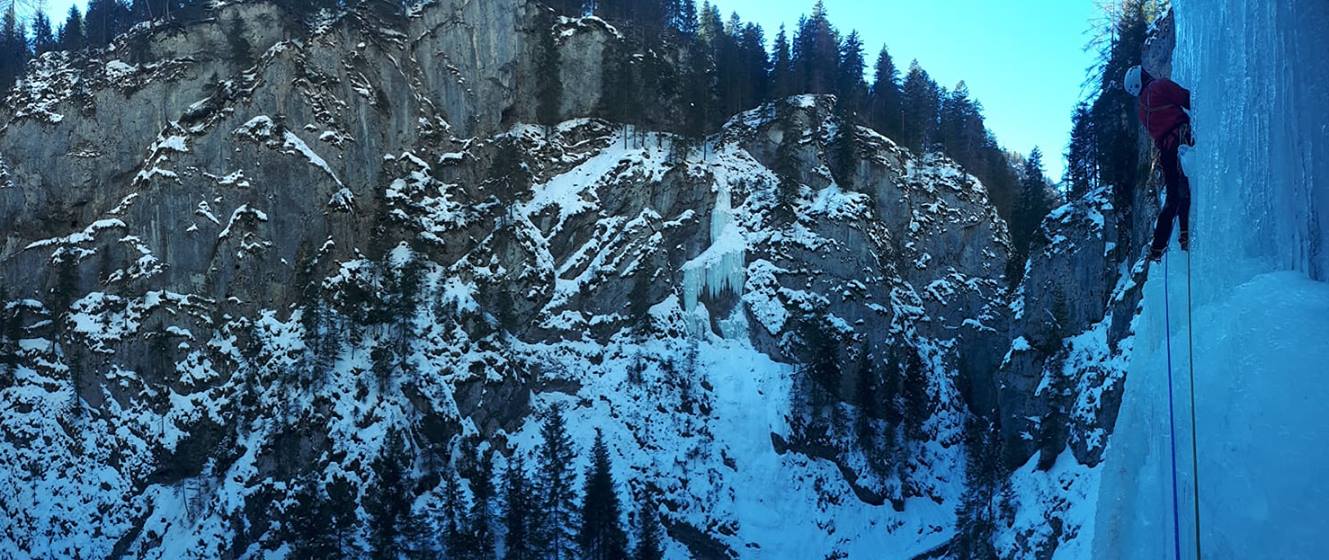
The Upper gorge
From here on, the routes are a little more spread out so I will describe them as you come to them, starting after the chapel where you cross a bridge.
On the left there are two, short hard dry lins, grade unknown.
Palestrina Destra WI2+, 30m
Cross the river and start by a fallen tree. The route climbs up and left to a tree just where the angle of the slope becomes a little shallower.
Palestrina WI2, 35m **
An ideal route for the beginner, or as a first ice lead. Cross the river to the right hand side of the gorge. The line follows a shallow stream with a short step
Kill Bill WI5/M, 25m
This is a mixed route on the left as you approach Excalibur. It climbs a leftward trending corner using bolts for protection
Moulinette WI4+, 40m*
To the right of Kill Bill, this follows a right trending corner and has massively variable amounts depending on the year which affects both difficulty and protectability!
On the right there is a bolted dry line which rarely holds any ice. No details of dificulty at this stage.
Excalibur WI4+, 3 pitches, 100m ****
Winter transforms this gushing waterspout into a long, excellent route, and is considered to be the crown jewel of the gorge. The falls have a huge volume of water and so often form a thick column of ice on all the pitches. The first pitch has 2 main lines, left or right of the column whereas the top two pitches are more wall climbing, with the climber choosing their line.
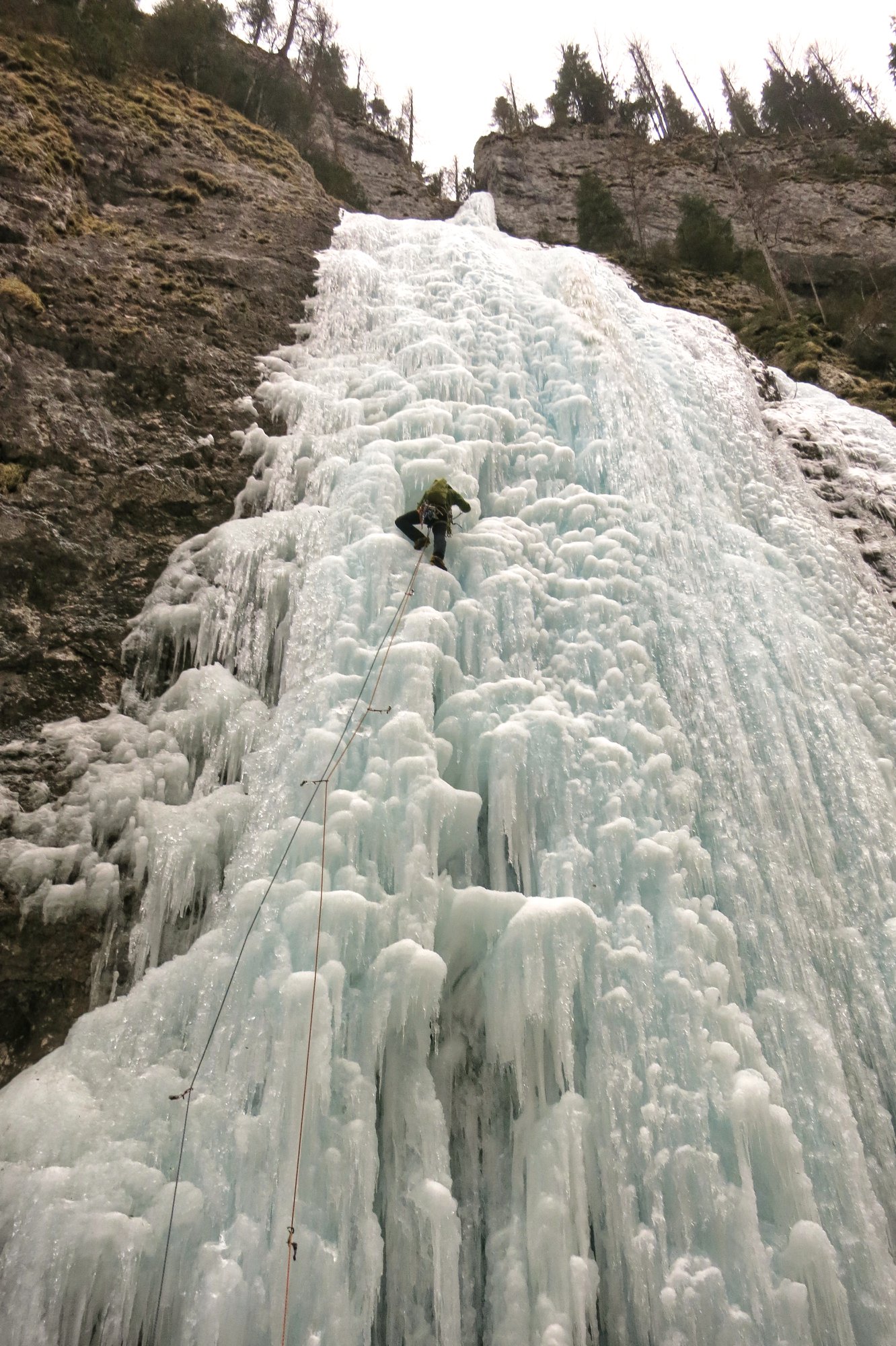
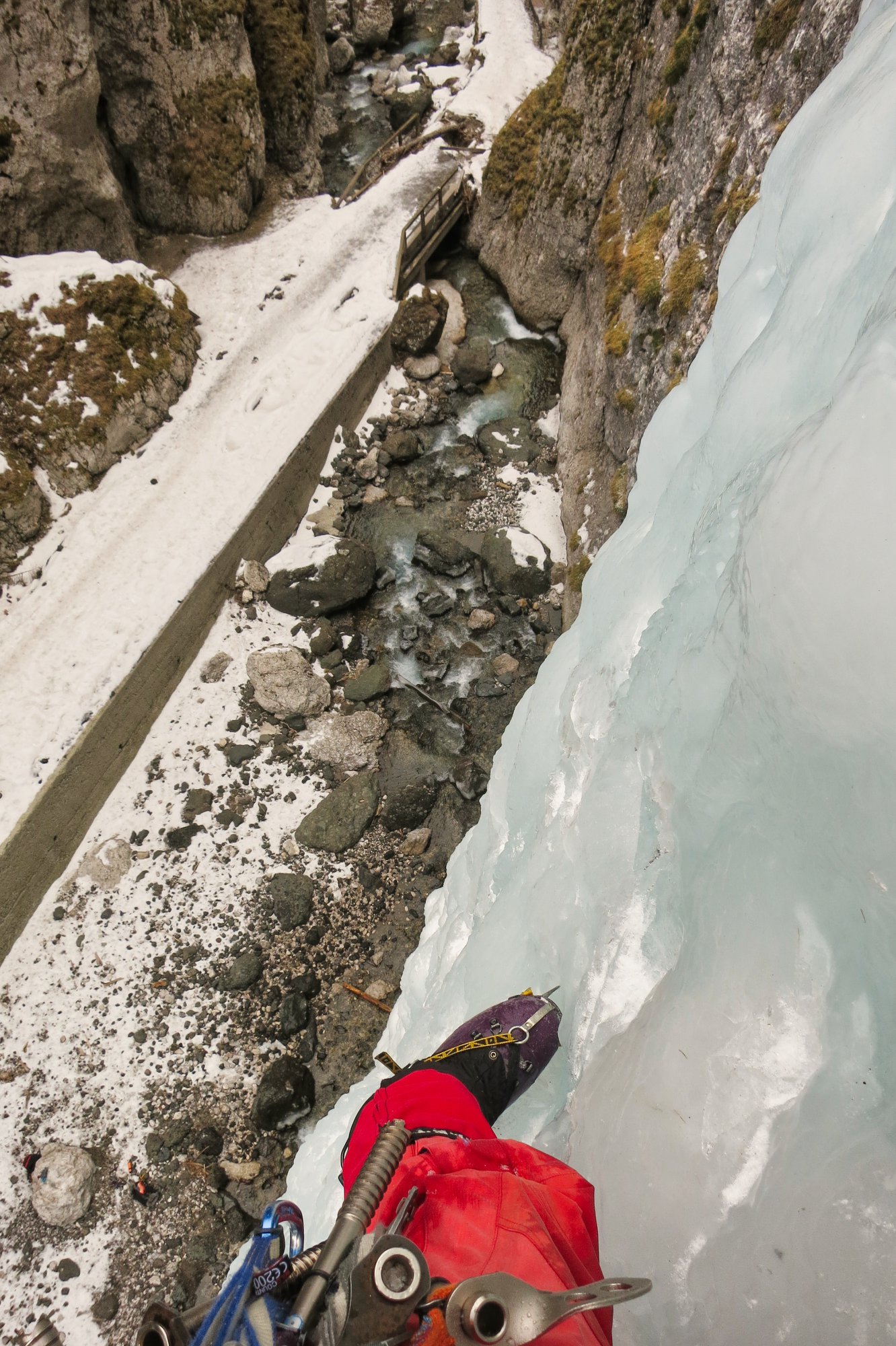
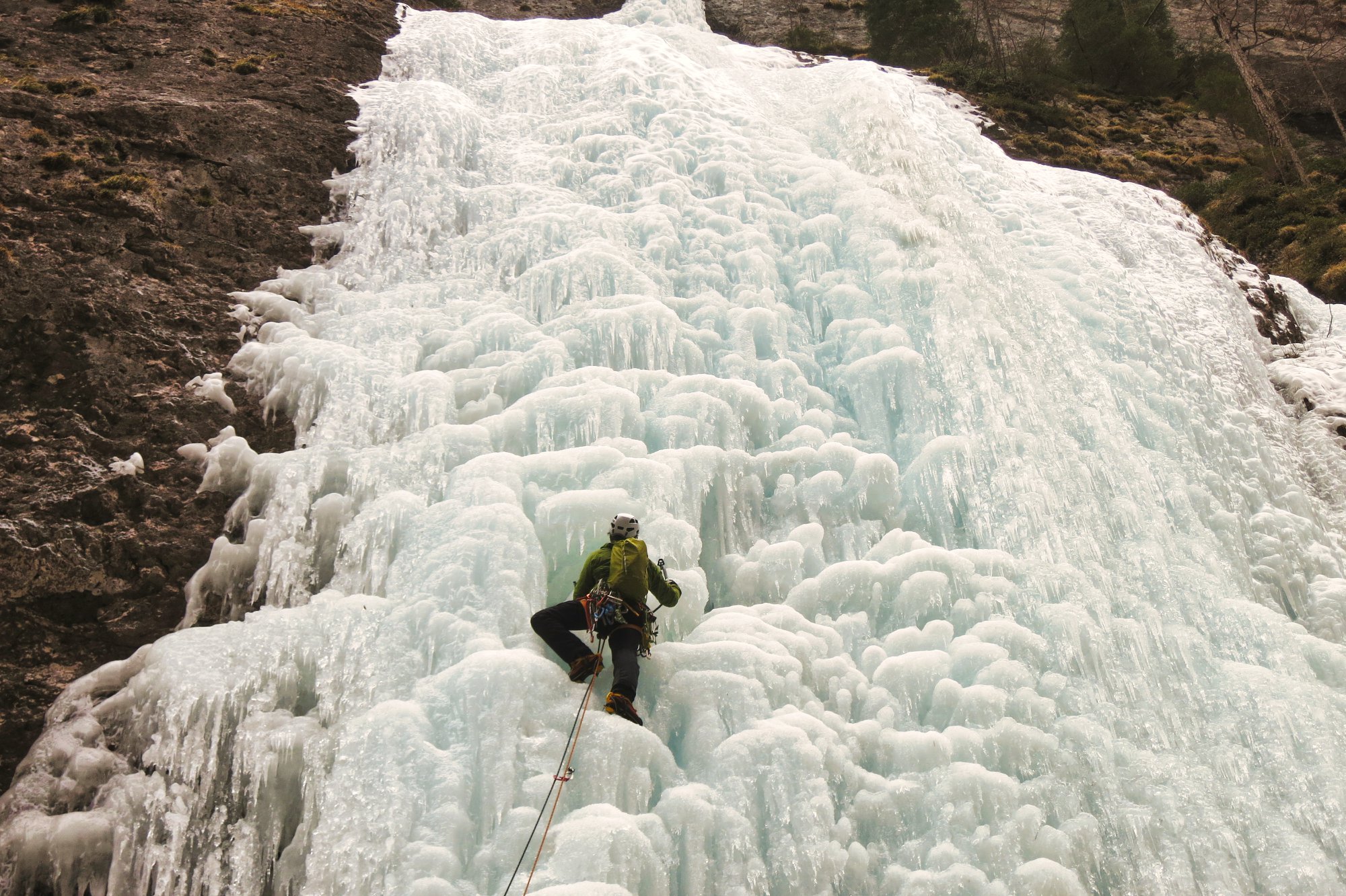
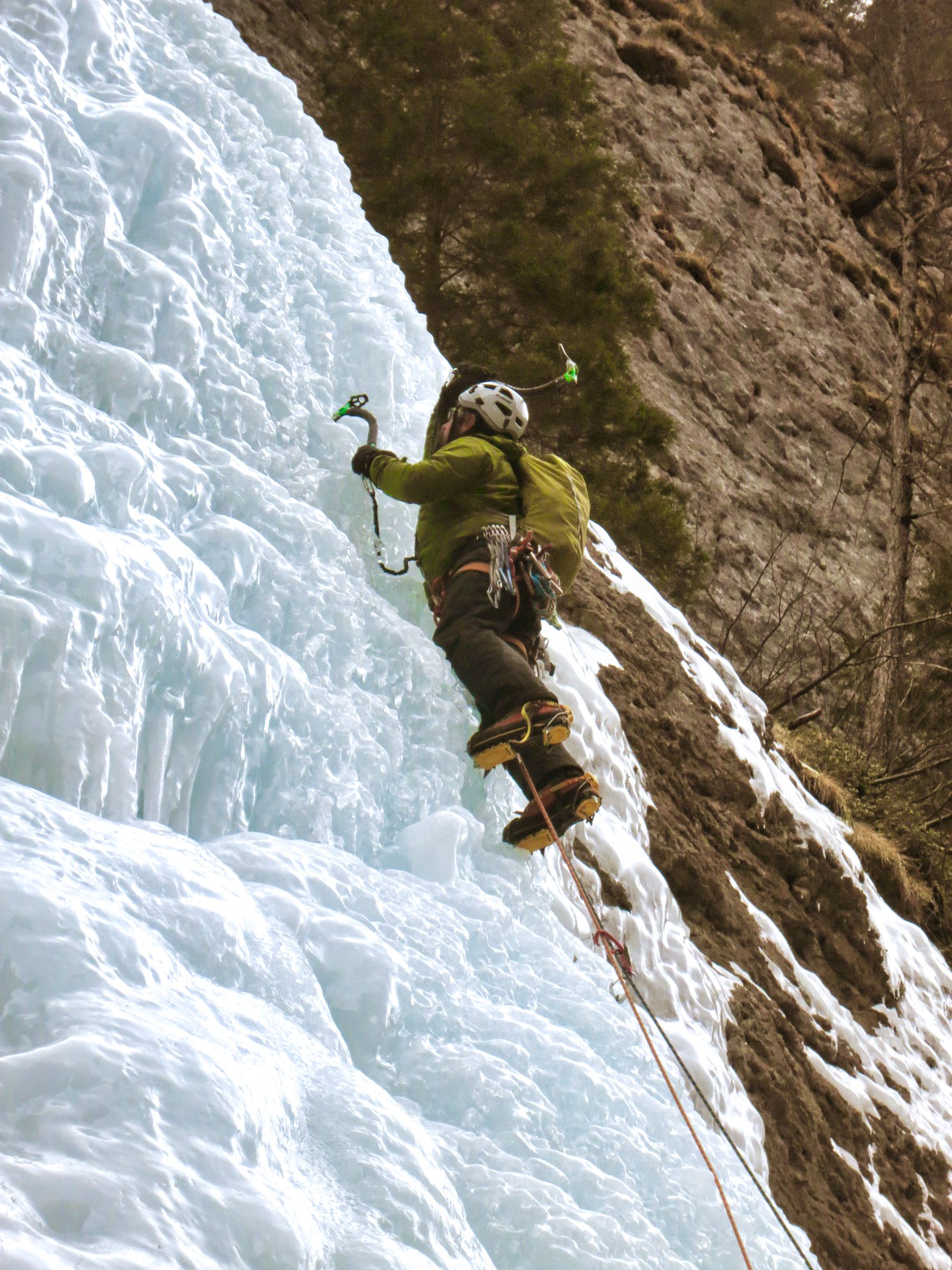
Lingua d’Argento WI5, 2 pitches, 100m
Just to the right of Excalibur. This route climbs thin ice up a slab to a cave near the top of the cliff in two pitches. Requires a wet season to form. Often the first 25m of te route are very thin indeed. Equipped belays.
Rugadia WI4, 20m
Continue up the valley from Excalibur and just before a bridge on the right you will see a small ice fall which starts with a mixed section. An ice hook for this initial section is useful protection as there is no other protection available when the ice is thin. Climb thin bridging moves up a corner and then pull up left onto buried turf. This section requires care. Then climb through a narrow section with increasing volumes of ice to reach a fat icicle. Climb this to a poor bolted and peg belay. Alternatively if you’ve had enough there is usually a piece of tat on a tree to the right just of the ice fall before you commit to the steep ice moves. The belay does require replacement.
Vecchia sosta WI5/M6, 30
Placca d’Argento WI6, 55m
Arbre Magique WI4, 30m
Follow the valley until you see a relatively new pumping house to the left with information boards. Directly opposite there are some ice falls. Arbre Magique climbs the right hand line. Make a long span to reach over the torrent and climb an initial vertical wall for 10m’s. The angle eases and the route becomes a little stepped before reaching a tree belay. Abseil descent.
Arbre Magique Sinistra, WI4, 30m
At the top of the gorge opposite a new pumping house there are some falls. This is the left hand line which weaves it’s way up to a steep step of about 8-10m. There are often hooks and chandeliers here. Surmount the bulge and then move right to a small pillar where you exit to a tree and an abseil descent.

